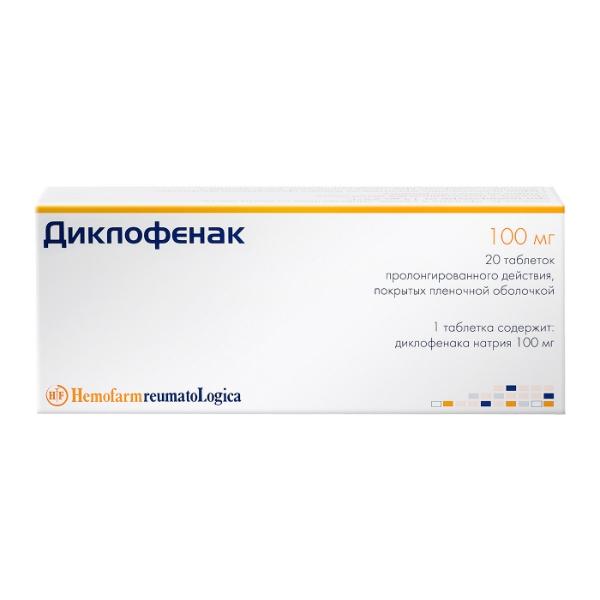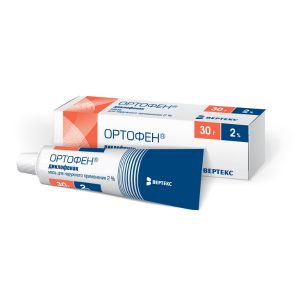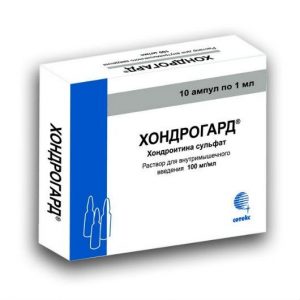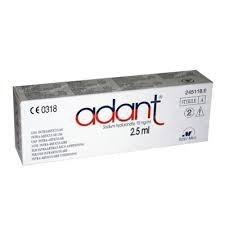Description
Description
Round biconvex tablets coated with a pink film coating on a white to almost white cross section of the core.
Release form
Sustained-release tablets.
packaging 20 pcs
Pharmacological action
Nonsteroidal anti-inflammatory drug (NSAID), a derivative of phenylacetic acid. Diclofenac has anti-inflammatory, analgesic, antiplatelet and antipyretic effects. Indirectly inhibiting cyclooxygenase 1 and 2 (COX1 and COX2), disrupts the metabolism of arachidonic acid, reduces the number of prostaglandins in the focus of inflammation. Most effective for pain of an inflammatory nature. In rheumatic diseases, the anti-inflammatory and analgesic effects of diclofenac significantly reduce the severity of pain, morning stiffness, swelling of the joints, which improves the functional state of the joint. For injuries in the postoperative period, diclofenac reduces pain and inflammatory edema.
Indications
Symptomatic treatment of diseases of the musculoskeletal system (rheumatoid arthritis, psoriatic arthritis, juvenile chronic arthritis, ankylosing spondylitis (ankylosing spondylitis) gouty arthritis, rheumatic soft tissue rheumatoid arthritis, peripheral osteoarthritis, and pulmonary arteriomas bursitis). The drug relieves or reduces pain and inflammation during the treatment period, while not affecting the progression of the disease. Mild to moderate pain syndrome: neuralgia, myalgia, lumbar ischialgia, post-traumatic pain syndrome, accompanied by inflammation, postoperative pain, headache, migraine, algodismenorrhea, adnexitis, proctitis, toothache. As part of the complex treatment of infectious and inflammatory diseases of the ear, throat, nose with severe pain (pharyngitis, tonsillitis, otitis media).
Contraindications
Hypersensitivity to the active substance (including other NSAIDs) or auxiliary components Complete or incomplete combination of bronchial asthma, recurrent nasal polyposis and paranasal sinuses and intolerance to acetylsalicylic acid or others. non-steroidal anti-inflammatory drugs (including a history) Erosive-ulcerative changes in the mucous membrane of the stomach or duodenum, active gastrointestinal bleeding Inflammatory bowel disease (ulcerative colitis, Crohn’s disease) in the acute phase The period after coronary artery bypass grafting III trimester pregnancy, lactation Confirmed chronic heart failure (NYHA class II-IV functional class) Coronary heart disease Peripheral lesion arteries or cerebrovascular disorders Hematopoietic disorders, hemostasis disorders (including hemophilia) Severe liver failure or active liver disease Severe renal failure (creatinine clearance less than 30 ml / min) progressive kidney disease Confirmed hyperkalemia Sucrose / isomaltase deficiency, fructose intolerance, glucose-galactose malabsorption (the drug contains sucrose). Children under 18 years old. Precautions Anemia, bronchial asthma, confirmed NYHA class I functional class I heart failure, arterial hypertension, edema syndrome, liver or kidney failure (creatinine clearance 30-60 ml / min), dyslipidemia, hyperlipoproteinemia, diabetes mellitus, smoking, inflammatory diseases intestines, a condition after extensive surgery, induced porphyria, diverticulitis, systemic diseases of the connective tissue, pregnancy I-II trimester. Anamnestic data on the development of peptic ulcer of the gastrointestinal tract, the presence of Helicobacter pylori infection, old age, prolonged use of NSAIDs, frequent alcohol consumption, severe somatic diseases. Concomitant therapy with anticoagulants (e.g. warfarin), antiplatelet agents (e.g. acetylsalicylic acid, clopidogrel), oral glucocorticosteroids (e.g. prednisolone), selective serotonin reuptake inhibitors (e.g. citalopram, fluoxetine, paroxetine, sertrin). In patients with seasonal allergic rhinitis, swelling of the nasal mucosa (including with nasal polyps), chronic obstructive pulmonary disease, chronic respiratory infections (especially associated with allergic rhinitis-like symptoms), with an allergy to other drugs, in patients with a significant decrease in the volume of circulating blood, diclofenac should be used with caution.
Recommendations for the use of
In all patients receiving diclofenac, it should be used in the minimum effective dose for the shortest time required to reduce the severity of symptoms. Inside, without chewing, during or after a meal, drinking plenty of water. 1 tablet once a day. If necessary, an additional dose of the drug is used in tablets of 50 mg. The maximum daily dose is 150 mg.
Pregnancy and lactation
Insufficient safety data for diclofenac in pregnant women. Therefore, diclofenac should be prescribed in the first and second trimesters of pregnancy only in cases where the expected benefit to the mother outweighs the potential risk to the fetus. Diclofenac, like other inhibitors of prostaglandin synthesis, is contraindicated in the last 3 months of pregnancy (suppression of uterine contractility and premature closure of the ductus arteriosus in the fetus is possible).
Diclofenac passes into breast milk in small amounts. To prevent unwanted effects on the child, the drug should not be prescribed to lactating women. If it is necessary to use the drug, breastfeeding should be discontinued.
Special instructions
In order to reduce the risk of adverse events, the drug should be used at the lowest effective dose for the shortest period necessary to relieve symptoms. Therapy of NSAIDs, including diclofenac, in particular long-term therapy and high-dose therapy, may be associated with a slight increase in the risk of developing serious cardiovascular thrombotic complications (including myocardial infarction and stroke). In patients with significant risk factors for cardiovascular events (e.g. arterial hypertension, hyperlipoproteinemia, diabetes mellitus and smoking), treatment with diclofenac-containing drugs should only begin after a thorough examination and analysis. Due to the important role of prostaglandins in maintaining renal blood flow, particular care should be taken when prescribing the drug to patients with heart or kidney failure, hypertension, elderly patients, patients taking diuretics or other drugs that affect renal function, as well as patients who have for any reason, there is a decrease in the volume of circulating blood (for example, after extensive surgery). If diclofenac is prescribed in such cases, it is recommended that kidney function be monitored as a precaution. After discontinuation of drug therapy, normalization of renal function indices to initial values is usually noted. When using diclofenac, phenomena such as bleeding or ulceration / perforation of the gastrointestinal tract were noted, in some cases fatal. These phenomena can occur at any time during the use of the drug in patients with the presence or absence of previous symptoms and serious gastrointestinal diseases in the anamnesis or without them. In elderly patients, such complications can have serious consequences. If patients receiving diclofenac develop, bleeding or ulceration of the gastrointestinal tract should be discontinued. To reduce the risk of toxic effects on the gastrointestinal tract, the drug should be used in the minimum effective dose for the shortest possible time, especially for patients with gastric ulcer, especially complicated history of bleeding or perforation, as well as elderly patients. Patients at increased risk of developing gastrointestinal complications, as well as those receiving therapy with low doses of acetylsalicylic acid or other drugs that can increase the risk of damage to the gastrointestinal tract, gastroprotectors should be taken. Patients with a history of gastrointestinal damage, especially the elderly, should inform the doctor about all the symptoms of the digestive system. During long-term therapy, it is necessary to monitor liver function, peripheral blood picture, fecal occult blood test. With prolonged use of diclofenac, an increase in the activity of one or more “liver” enzymes may be noted. With the preservation and progression of impaired hepatic function or the occurrence of signs of liver disease or other symptoms (eg, eosinophilia, rash, etc.), the drug should be discontinued. Keep in mind that hepatitis with the use of diclofenac can develop without prodromal phenomena. Caution must be observed when using diclofenac in patients with hepatic porphyria, since the drug can provoke attacks of porphyria. Diclofenac can reversibly inhibit platelet aggregation, therefore, in patients with hemostatic disorders with prolonged use, it is necessary to carefully monitor the relevant laboratory parameters. In patients with bronchial asthma, seasonal allergic rhinitis, swelling of the nasal mucosa (including with nasal polyps), chronic obstructive pulmonary disease, chronic respiratory infections (especially associated with allergic rhinitis-like symptoms), as well as in patients with allergies to other medications (rash, itching, urticaria) when prescribing diclofenac, special care should be taken (readiness for resuscitation). When using diclofenac, very rarely reported severe, in some cases fatal, skin reactions, including exfoliative dermatitis, Stevens-Johnson syndrome, toxic epidermal necrolysis. The greatest risk and frequency of severe dermatological reactions were noted in the first month of diclofenac treatment. With the development in patients receiving the drug, the first signs of a skin rash, damage to the mucous membranes, or other symptoms of hypersensitivity, diclofenac should be canceled. The anti-inflammatory effect of NSAIDs, including diclofenac, can complicate the diagnosis of infectious processes. Due to the negative effect on fertility, women planning a pregnancy, the drug is not recommended. In patients with infertility (including those undergoing examination), it is recommended to cancel the drug. When taking 100 mg tablets for patients with diabetes mellitus, the content of sucrose in the preparation should be taken into account (94.7880 mg of sucrose in 1 tablet). Impact on the ability to drive vehicles and work with mechanisms Patients who experience visual disturbances, dizziness, drowsiness, or other disorders of the central nervous system while using diclofenac should not drive vehicles and work with mechanisms.
Composition
One sustained-release film-coated tablet contains: active ingredient: diclofenac sodium 100.0000 mg excipients: sucrose – 94.7880 mg, cetyl alcohol – 54.8200 mg, colloidal silicon dioxide – 0.7900 mg , talc – 3.95500 mg, povidone K-25 – 1.0530 mg, magnesium stearate – 7.8990 mg shell: hypromellose – 3.4355 mg, titanium dioxide E 171 CI 77891 – 0.8649 mg, talc – 2, 4178 mg, polysorbate 80 – 0.3826 mg, macrogol 6000 – 0.6894 mg, crimson dye [Ponceau 4R] [E124] – 0.0441 mg, brown dye [sunset sunset yellow [E 110] + dye azorubine [E122] + diamond black dye [E151]] – 0.0147 mg, aluminum varnish based on dye sunny sunset yellow [E110] – 0.0500 mg.
Dosage and Administration
In all patients receiving diclofenac, it should be used in the minimum effective dose for the shortest time required to reduce the severity of symptoms.
Inside, without chewing, during or after a meal, with plenty of water.
1 tablet 1 time per day. If necessary, an additional dose of the drug is used in tablets of 50 mg. The maximum daily dose is 150 mg.
Side effects
Criteria for evaluating the incidence of adverse reactions: very common (> 1/10), often ( 1/100, <1/10), infrequent ( 1/1000, <1/100), rare ( 1 / 10000, <1/1000) and very rarely (<1/10000) the frequency is unknown - it is not possible to set the frequency of occurrence according to available data. Disorders of the gastrointestinal tract: often - epigastric pain, nausea, vomiting, diarrhea, dyspepsia, flatulence, anorexia rarely - gastritis, proctitis, gastrointestinal bleeding (gastrointestinal tract) (vomiting with blood, melena, diarrhea with blood admixture), ulcers of the gastrointestinal tract (with or without bleeding or perforation) is very rare - stomatitis, glossitis, esophagitis, non-specific hemorrhagic colitis, exacerbation of colitis or colitis Crohn, occurrence of diaphragm-like strictures in the intestine, constipation, pancreatitis. Disorders from the liver and biliary tract: often - increased activity of aminotransferases is rare - hepatitis, jaundice, impaired liver function is very rare - hepatic malignancy, liver necrosis, liver failure. Nervous system disorders: often - headache, dizziness rarely - drowsiness very rarely - impaired sensitivity, incl. paresthesias, memory disorders, tremors, convulsions, anxiety, cerebrovascular disorders, aseptic meningitis. Mental disorders: very rarely - disorientation, depression, insomnia, nightmares, irritability, mental disorders. Violations by the senses: often - vertigo very rarely - impaired vision (blurred vision, diplopia), hearing impairment, tinnitus, impaired taste. Renal and urinary tract disorders: very rarely - acute renal failure, hematuria, proteinuria, interstitial nephritis, nephrotic syndrome, papillary necrosis. Violations from the blood and lymphatic system: very rarely - thrombocytopenia, leukopenia, hemolytic and aplastic anemia, agranulocytosis, eosinophilia. Immune system disorders: anaphylactic / anaphylactoid reactions, including marked decrease in blood pressure (BP) and shock very rarely - angioneurotic edema (including facial). Violations by the cardiovascular system: very rarely - palpitations, chest pain, high blood pressure, vasculitis, heart failure, myocardial infarction. Disorders from the respiratory system, chest and mediastinum: rarely - exacerbation of bronchial asthma, cough, laryngeal edema very rarely - pneumonitis. Skin and subcutaneous tissue disorders: often - skin rash is rare - urticaria is very rare - bullous rashes, eczema, incl. multiforme and Stevens-Johnson syndrome, Lyell's syndrome, exfoliative dermatitis, itching, hair loss, photosensitization, purpura, incl. allergic. General disorders and disorders at the injection site: rarely - edema. Drug Interaction Lithium Drugs, Digoxin: Diclofenac may increase lithium and digoxin concentrations in blood plasma. Monitoring of plasma lithium and digoxin concentrations when co-administered with diclofenac is recommended. methotrexate: caution should be exercised when administering diclofenac less than 24 h before or 24 h after methotrexate administration. in such cases, the concentration of methotrexate in the blood may increase and its toxic effect may increase. Cyclosporine: the effect of diclofenac on the synthesis of prostaglandins in the kidneys may enhance the nephrotoxicity of cyclosporine. Therefore, the doses of diclofenac used should be lower than in patients, not using cyclosporine. Diuretic and antihypertensive drugs: Diclofenac may reduce the antihypertensive effect of diuretic and antihypertensive drugs (eg, beta-blockers, angiotensin converting enzyme inhibitors – ACE). For patients, especially the elderly, these combinations should be administered with caution and regular monitoring of blood pressure. Patients should be adequately hydrated. After initiation and periodically during treatment, especially with the simultaneous administration of diuretic agents and ACE inhibitors, renal function should be monitored due to the increased risk of nephrotoxicity. Drugs capable of causing hyperkalemia: concomitant use of diclofenac with potassium-sparing diuretics, cyclosporine, tacrolimus or trimethoprim may lead to an increase in serum potassium (this indicator should be monitored on a regular basis if used with this combination of drugs). Antibacterials – Quinolone Derivatives: There are separate reports of seizures in patients receiving quinolone derivatives and diclofenac at the same time. Anticoagulants and antiplatelet agents: it is necessary to combine diclofenac with these groups with caution because of the risk of bleeding. Although clinical studies have not shown the effect of diclofenac on the action of anticoagulants, there are some reports of increased bleeding risk in patients taking this combination. Therefore, In the case of such a combination of medicines, regular and careful monitoring of patients is recommended. Acetylsalicylic acid lowers the concentration of diclofenac in the blood. NSAIDs and corticosteroids: The concomitant systemic use of diclofenac and other systemic NSAIDs or corticosteroids may increase the incidence of side effects (particularly from the gastrointestinal tract). Selective serotonin reuptake inhibitors (SSRIs): concomitant use of diclofenac and SSRIs increases the risk of gastrointestinal bleeding. Hypoglycemic drugs: clinical studies have found that when combined with diclofenac, it does not affect the effectiveness of hypoglycemic drugs. However, separate reports of development in such cases as hypoglycemia and hyperglycemia were known, which required a change in the dose of hypoglycemic drugs during diclofenac therapy. Therefore, it is recommended that blood glucose be monitored during the combined use of diclofenac and hypoglycemic agents. Phenytoin: Phenytoin and diclofenac should be administered concomitantly with the control of phenytoin in the blood plasma due to the potential for increased systemic effects. Tacrolimus: may increase nephrotoxicity when co-administered with diclofenac. Cefamandol, cefoperazone, cefotetan, valproic acid and plicamycin increase the incidence of hypoprothrombinemia. The effect of diclofenac on the synthesis of prostaglandins in the kidneys may enhance the toxic effect of gold preparations. Concomitant use with ethanol, colchicine, corticotropin, and pierced Hypericum drugs increases the risk of bleeding in the gastrointestinal tract. Powerful CYP2C9 isoenzyme inhibitors: shouldCaution should be exercised when co-prescribing diclofenac and potent CYP2C9 isoenzyme inhibitors (such as voriconazole) due to possible increases in serum diclofenac concentrations and increased systemic action. Overdose Symptoms: vomiting, bleeding from the digestive tract, diarrhea, dizziness, tinnitus, cramps, increased blood pressure, respiratory depression, with significant overdose – acute renal failure, hepatotoxic effect. Treatment: gastric lavage, activated charcoal, symptomatic therapy aimed at eliminating the increase in blood pressure, impaired renal function, seizures, gastrointestinal tract damage, respiratory depression. Forced diuresis, hemodialysis are ineffective (due to a significant connection with proteins and intense metabolism). Expiration 4 years. Do not use after the expiry date stated on the packaging. active substance Diclofenac drugstores drugstores drugstore terms pharmacy drugstore drugstore terms f50 pharmacy dl50p50 p50 º Pharmacy terms of delivery Prescription




